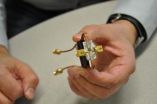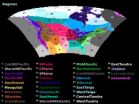(Press-News.org) Several scientists, including one at Simon Fraser University, have made a discovery that strongly links a little understood molecule, which is similar to DNA, to cancer and cancer survival.
EMBO Reports, a life sciences journal published by the European Molecular Biology Organization, has just published online the scientists' findings about small non-coding RNAs.
While RNA is known to be key to our cells' successful creation of proteins, the role of small non-coding RNAs, a newly discovered cousin of the former, has eluded scientific understanding for the most part. Until now, it was only surmised that most of these molecules had nothing to do with protein production.
However, scientists at SFU, the University of British Columbia and the B.C. Cancer Agency have discovered that many non-coding RNAs are perturbed in cancerous human cells, including breast and lung, in a specific way. The disturbance, which manifests itself as shorter than normal molecular messaging, also occurs at a specific spot on genes.
"These two identifiable characteristics give cancer-causing non-coding RNAs a chemical signature that makes it easy for scientists to identify them in the early stages of many different types of cancer," says Steven Jones.
The SFU molecular biology and biochemistry professor is this study's senior author, and the associate director and head of bioinformatics at the B.C. Cancer Agency's Genome Sciences Centre.
"These molecules' existence can also be used to classify cancer patients into subgroups of individuals with different survival outcomes," adds Jones. "While the precise reason why a tumour would change the behaviour of genes in this way is not known, it is likely that it represents a mechanism by which the cancer can subvert and takeover the normally well controlled activity of our genes."
This study uncovered non-coding RNAs' cancerous role by using high-throughput sequencing techniques to analyse reams of genetic information on normal and diseased tissue as part of the Cancer Genome Atlas project.
The Cancer Genome Atlas is an ambitious project to characterize the genetic material of more than 500 tumours from more than 20 different cancers. The project provides a goldmine of data for bioinformaticians such as Jones.
INFORMATION:
Simon Fraser University is consistently ranked among Canada's top comprehensive universities and is one of the top 50 universities in the world under 50 years old. With campuses in Vancouver, Burnaby and Surrey, B.C., SFU engages actively with the community in its research and teaching, delivers almost 150 programs to more than 30,000 students, and has more than 125,000 alumni in 130 countries.
Simon Fraser University: Engaging Students. Engaging Research. Engaging Communities.
Contact:
Steven Jones (Vancouver resident), 604.877.6083, sjones@bcgsc.ca
Carol Thorbes, PAMR, 778.782.3035, cthorbes@sfu.ca
Jenn Currie, B.C. Cancer Agency, communications, 604.675.8106, jenn.currie@bccancer.bc.ca
Photos: http://i.sfu.ca/KMnjeF
Molecular aberration signals cancer
2014-02-19
ELSE PRESS RELEASES FROM THIS DATE:
Cell therapy shows remarkable ability to eradicate cancer in clinical study
2014-02-19
NEW YORK, February 19, 2014 — Investigators from Memorial Sloan Kettering Cancer Center have reported more encouraging news about one of the most exciting methods of cancer treatment today. The largest clinical study ever conducted to date of patients with advanced leukemia found that 88 percent achieved complete remissions after being treated with genetically modified versions of their own immune cells. The results were published today in Science Translational Medicine.
"These extraordinary results demonstrate that cell therapy is a powerful treatment for patients who ...
LGBT youth face greater cancer risks, CCNY-led study
2014-02-19
A new study led by City College of New York psychologist Margaret Rosario found that youths of same-sex orientation are more likely to engage in behaviors associated with cancer risk than heterosexuals. The peer-reviewed findings appear in the February 2014 issue of the American Journal of Public Health.
Titled "Sexual Orientation Disparities in Cancer-Related Risk Behaviors of Tobacco, Alcohol, Sexual Behaviors, and Diet and Physical Activity: Pooled Youth Risk Behavior Surveys," the study pooled YRBS (Youth Risk Behavior Survey) data from 2005 and 2007. The YRBS is ...
Using holograms to improve electronic devices
2014-02-19
RIVERSIDE, Calif. (http://www.ucr.edu) — A team of researchers from the University of California, Riverside Bourns College of Engineering and Russian Academy of Science have demonstrated a new type of holographic memory device that could provide unprecedented data storage capacity and data processing capabilities in electronic devices.
The new type of memory device uses spin waves – a collective oscillation of spins in magnetic materials – instead of the optical beams. Spin waves are advantageous because spin wave devices are compatible with the conventional electronic ...
Statistics research could build consensus around climate predictions
2014-02-19
Philadelphia, PA—Vast amounts of data related to climate change are being compiled by research groups all over the world. Data from these many and various sources results in different climate projections; hence, the need arises to combine information across data sets to arrive at a consensus regarding future climate estimates.
In a paper published last December in the SIAM Journal on Uncertainty Quantification, authors Matthew Heaton, Tamara Greasby, and Stephan Sain propose a statistical hierarchical Bayesian model that consolidates climate change information ...
Smellizing -- imagining a product's smell -- increases consumer desire, study finds
2014-02-19
Seeing is believing, but smellizing – a new term for prompting consumers to imagine the smell of a product – could be the next step toward more effective advertising.
Researchers came to this conclusion through four studies of products most of us would like to smellize: cookies and cake.
Professor of Marketing Maureen Morrin of Temple University's Fox School of Business co-authored Smellizing Cookies and Salivating: A Focus on Olfactory Imagery to examine the impact imagining what a food smells like would have on consumer behavior.
"Before we started this project, ...
Discovery by Baylor University researchers sheds new light on the habitat of early apes
2014-02-19
WACO, Texas (Feb. 18, 2014)-- Baylor University researchers, in collaboration with an international team of scientists, have discovered definitive evidence of the environment inhabited by the early ape Proconsul on Rusinga Island, Kenya. The groundbreaking discovery provides additional information that will help scientists understand and interpret the connection between habitat preferences and the early diversification of the ape-human lineage.
Their research findings--published this month in Nature Communications--demonstrate that Proconsul and its primate relative Dendropithecus ...
Graduate student makes major discovery about seal evolution
2014-02-19
Ottawa, February, 19, 2014—In the world of science, one of the most exciting things a researcher can do is pin down an answer to a widely asked question. This experience came early for Carleton University graduate Thomas Cullen, who made a discovery about pinnipeds—the suborder that makes up seals, sea lions and walruses—while doing research for his Master's degree under the supervision of Canadian Museum of Nature palaeontologist Dr. Natalia Rybczynski.
His discovery, published the journal Evolution, relates to sexual dimorphism (a large variance in size between males ...
Huntington's disease: Hot on the trail of misfolded proteins' toxic modus operandi
2014-02-19
WASHINGTON D.C. Feb. 19, 2014 -- Proteins are the workhorses of the cell, and their correctly folded three-dimensional structures are critical to cellular functions. Misfolded structures often fail to properly perform these vital jobs, leading to cellular stress and devastating neurodegenerative disorders such as Alzheimer's, Parkinson's and Huntington's disease.
In comparison with the mysteries of Alzheimer's or Parkinson's disease, Huntington's disease has a seemingly simple culprit: an expansion in the polyglutamine (polyQ) tract of a protein called "Huntingtin" (Htt). ...
Rutgers scientists identify structure of virus that could lead to hepatitis C vaccine
2014-02-19
Rutgers University scientists have determined the structure of a hepatitis C surface protein, a finding that could assist in the development of a vaccine to halt the spread of the the deadly disease that has infected 3.2 million Americans.
Joseph Marcotrigiano, associate professor of chemistry and chemical biology, says this new research – published online today in Nature – describes an outer region of hepatitis C that enables the virus to evade the body's natural immune system response, causing persistent, chronic infection.
Hepatitis C is constantly mutating, allowing ...
The ups and downs of early atmospheric oxygen
2014-02-19
RIVERSIDE, Calif. — A team of biogeochemists at the University of California, Riverside, give us a nontraditional way of thinking about the earliest accumulation of oxygen in the atmosphere, arguably the most important biological event in Earth history.
A general consensus asserts that appreciable oxygen first accumulated in Earth's atmosphere around 2.3 billion years ago during the so-called Great Oxidation Event (GOE). However, a new picture is emerging: Oxygen production by photosynthetic cyanobacteria may have initiated as early as 3 billion years ago, with oxygen ...







